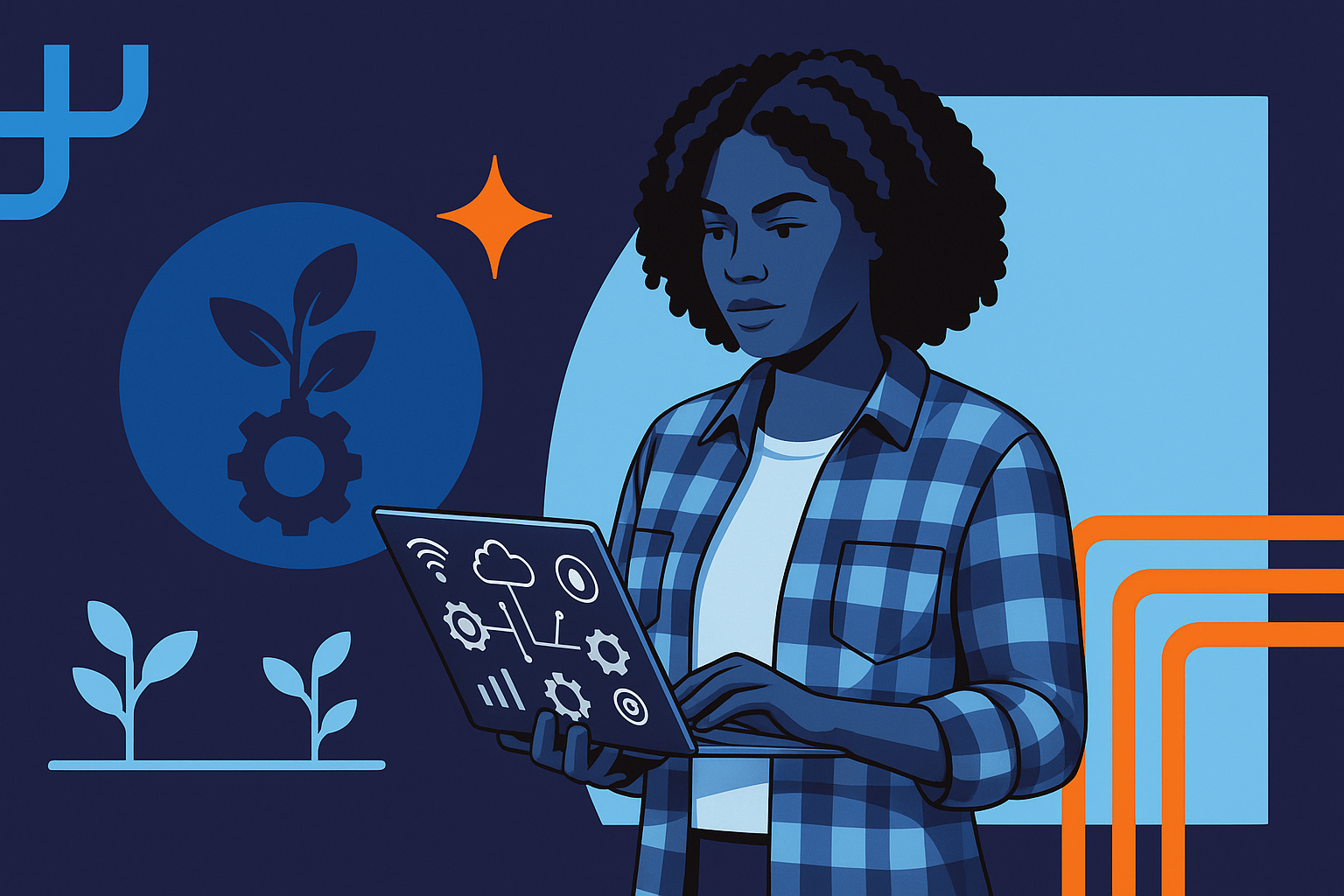How different does agriculture and farming look today compared to a decade ago?
From crop health monitoring to automated irrigation systems, technology is playing a bigger role in how we grow food and edge computing is quickly becoming one of the most valuable tools in the shed.
As the agriculture industry looks for ways to improve productivity and reduce waste, the integration of advanced technologies is reshaping everyday farming practices. And while data has always been part of the equation, the way it's used is changing. With edge computing, farmers can now analyze data, make decisions, and act – right there in the field – without having to wait for a connection to the cloud or rely on centralized data centers.
In this post, we’ll explore how agriculture edge computing is transforming the way farms operate, helping drive better outcomes and setting the stage for a more sustainable future in food production.
What edge computing means for agriculture
Edge computing isn’t a new invention, but its impact on farming is just starting to hit its stride. At its core, edge computing is about processing data as close to the source as possible – think tractors, sensors, and greenhouses – rather than sending everything off to a remote server or cloud platform.
In agriculture, this means that sensor data from things like soil monitors, weather stations, or animal trackers can be processed locally, on the farm itself. This kind of real-time processing enables farmers to react quickly when something changes – whether that’s shifting weather patterns, sudden temperature drops, or early signs of crop disease.
The result? Faster decisions, fewer delays, and smarter use of time and resources.
Why edge computing matters on the farm
So, what does all this mean in practice?
Instead of waiting for a server hundreds of miles away to crunch the numbers, edge computing enables farmers to manage key operations in the moment. That might look like adjusting irrigation based on updated weather forecasts, tweaking pest control strategies in real time, or fine-tuning feed schedules using health data from livestock.
It’s also helping farms overcome a major hurdle: limited internet connectivity. Many rural operations can’t rely on stable connections. But with edge computing capabilities, essential systems can run independently, without needing a constant link to the cloud.
This technology supports more than just fast reactions – it helps farmers make better long-term choices, too. By putting data-driven decision making at the center of everyday work, edge computing plays a key role in improving crop yields, managing resource usage, and building toward sustainable agriculture.
What edge computing means for farming
At its core, edge computing refers to processing data closer to where it’s created – right there on the tractor, in the greenhouse, or through a nearby wireless sensor network. Instead of sending everything to the cloud and waiting for it to crunch the numbers, the data is processed locally, at the edge.
This local approach makes a big difference for farmers. Let’s say a temperature sensor detects a heat spike in the soil. With edge computing capabilities, the system can adjust irrigation instantly, without waiting for a signal to go back and forth through the cloud.
It’s particularly useful in rural areas, where limited internet connectivity can make cloud-reliant systems unreliable. Edge computing keeps things running smoothly, even when the connection drops.
How edge computing enables smarter farming
Smart farming isn’t just about tech – it’s about farming efficiency. It’s about using the agricultural data you’re already collecting and turning it into something useful.
By processing sensor data on-site, edge computing supports:
- Real-time monitoring of soil, crops, and livestock
- Quicker responses to changes in environmental parameters
- Lower operating costs through automation
- Smarter resource usage, like water and fertilizer
- Stronger data security with sensitive data kept on the farm
Pair that with artificial intelligence and machine learning techniques, and you’ve got a powerful toolkit. With these combined systems, farmers can detect early signs of crop disease, track shifting weather patterns, and optimize harvests using deep learning capabilities.
Real-world examples of edge in agriculture
Let’s break down how edge computing services are already improving daily farming operations and crop management in real-time.
Soil monitoring and precision agriculture
With sensor networks placed in the field, farmers can measure soil moisture, temperature, and nutrient content as it changes. This real-time insight supports data driven decision making, helping farmers apply water, fertilizer, or treatments only when and where they’re needed.
Edge-powered tools like variable rate technology allow for ultra-precise field management – meaning you can fine-tune pest control, reduce waste, and still boost crop yields.
Livestock management
Keeping animals healthy requires attention to detail – and edge computing helps deliver it.
Wearable sensors can monitor heart rate, activity levels, and feeding behavior. Since the data is processed locally, alerts go out right away if something looks unusual. That could be a sign of illness, injury, or simply a change in routine.
With this kind of insight, farmers can reduce risk, prevent disease spread, and improve overall farm productivity – all while keeping animals healthier and operations more efficient.
Greenhouse automation and crop health
In greenhouse settings, edge computing plays a key role in creating the right environment for crops to thrive.
Sensors constantly track environmental parameters like humidity, temperature, and light. Edge systems adjust things automatically, making sure plants stay within optimal growth conditions – even if the cloud connection is down.
In the field, drones and imaging systems use edge tech to scan crops and detect issues like pests or nutrient deficiencies. Instead of uploading massive image files to a server, analysis happens instantly on the device. That means quicker action and more accurate targeting, with fewer chemicals and less waste.
What edge computing infrastructure looks like on the farm
Behind the scenes, edge computing infrastructure brings together a mix of edge devices, sensor networks, and smart processing tools that work right where the data is collected.
These devices – things like soil sensors, weather monitors, or actuators – collect data directly from the field. That data is then analyzed using local edge computing capabilities to guide decisions in real time. Whether it’s adjusting irrigation or triggering a pest alert, these systems help fine-tune inputs and improve overall farm productivity.
Because everything is tied into one localized system, it’s easier to monitor operations, spot issues early, and make quick changes that keep crops growing strong.
Edge devices and real-time data collection
Edge devices are the boots-on-the-ground part of the system. They track moisture levels, measure soil temperature, monitor air quality, and watch for shifts in weather patterns. Instead of sending that data far away to be processed, they run calculations locally, using machine learning techniques and artificial intelligence to generate accurate predictions on the spot.
That means farmers don’t have to guess when to water or spray. The system figures it out and takes action – fast. With this kind of real time monitoring, growers can improve crop yields, reduce resource waste, and manage more acreage with less manual input.
And because everything is processed locally, farms don’t need strong internet connections to stay productive. That’s a game-changer for rural areas with limited connectivity.
Processing and analyzing the data that matters
At the heart of agriculture edge computing is smart, reliable data processing.
Once the data is collected, edge systems step in to make sense of it – flagging patterns in soil health, monitoring crop progress, or checking for signs of stress. With tools like deep learning capabilities, the insights go beyond surface-level. Farmers get real, actionable information they can use on the same day.
This tight feedback loop drives more efficient resource usage, cuts down on operating costs, and makes day-to-day farming practices more sustainable. And because decisions are made faster, farmers can stay ahead of challenges instead of reacting to them after the fact.
The power of connected, digital tools
Today’s digital technologies are opening doors for smarter, faster farming – and edge computing is what helps tie it all together.
When combined with emerging technologies like drones, autonomous tractors, and mobile apps, edge computing helps farms:
- Automate key tasks like planting, spraying, and harvesting
- Adjust to weather with better forecasting and scheduling
- Identify issues early, before they escalate
- Track the data collected each day to refine and repeat what works
It’s a system that adapts with the farmer, helping scale up the good and fix what isn’t quite right – without needing a team of data scientists to make it happen.
Smarter data, better sustainability
For farms trying to balance productivity with long-term health, sustainability isn’t just a goal – it’s a necessity. And edge computing supports that by making every input count.
By processing data locally, farmers can fine-tune their water and fertilizer use, lowering waste while boosting output. The result is healthier soil, stronger crops, and fewer unnecessary applications.
There’s also a security bonus. Since sensitive agricultural data stays on-site unless needed elsewhere, the risk of data breaches is much lower. That’s a big deal in an industry collecting more real-time data than ever before.
Moving toward wider adoption
The upside of edge computing is clear – but getting it into the hands of more farmers takes time.
Challenges like cost, skills training, and infrastructure still exist. But momentum is building. Hardware is becoming more affordable. Platforms are becoming more accessible. And interest across the agricultural sector is growing fast.
As more farms adopt edge tools, we’re likely to see major leaps in both agricultural production and sustainable farming practices. It's not just about growing more – it's about growing smarter.
Ready to put edge computing to work on your farm?
At Simply NUC, we build compact, customizable systems that bring processing power to the edge, right where farmers need it most. Whether it’s for greenhouses, livestock monitoring, or full-field analysis, we’re here to help you improve farming efficiency, boost crop quality, and build a smarter, more sustainable operation.









